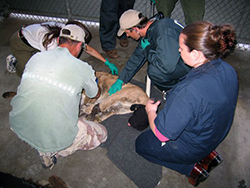
Wildlife training with a mountain lion at CDFW’s Wildlife Investigations Lab outside of Sacramento.
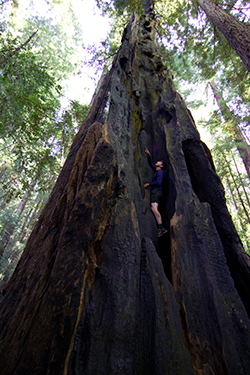
John climbs redwoods at Hendy Woods State Park in Mendocino County.
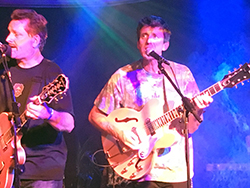
Wildlife biologist by day, rock guitarist by night in the band Sticky’s Backyard.
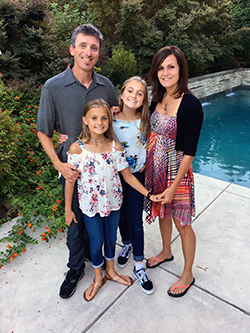
John with wife, Trish, and daughters Phoenix (left) and Sequoia.
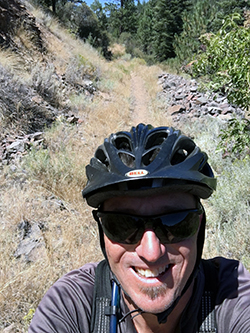
Mountain biker John near Lake Almanor.
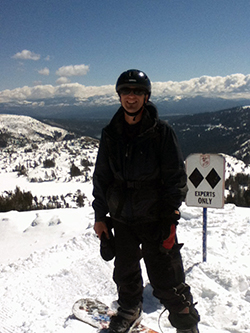
Snowboarders’ expert runs have the best views
Wildlife biologist John Krause is a 17-year CDFW employee who serves Marin, Alameda and Contra Costa counties. In the heavily populated San Francisco Bay Area, human-wildlife issues often dominate his workday. But his professional pride and joy is the Eden Landing Ecological Reserve near Hayward. John has spent his career overseeing the restoration of 6,400 acres of commercial salt ponds to tidal marsh and other natural habitat while creating access and recreational opportunities for the public.
A native of Carmichael in Sacramento County, John holds a degree in terrestrial plant ecology from UC Davis.
Do you find it ironic that you are a wildlife biologist working in some of the most urbanized communities in the country?
Sure, at times. When I took this job back in 2001, I did not really know how much of the human dimension aspect of things I would be getting into. It’s a regular part of the job, dealing with the public about everything from “Where can I go hunt?” to “I’ve got a problem with a coyote in my backyard.”
How much of your time is spent dealing with human-wildlife conflicts?
It’s every day. A lot of it is depredation-related calls from the public – wild pigs, wild turkeys in the urban-wildlife interface, occasionally deer out in the vineyards causing property damage. There are regular calls about coyotes being perceived as a public safety risk, though coyotes are really more of a risk to domestic animals like cats, small dogs and backyard, free-ranging chickens. The number of these incidents is definitely increasing, primarily because we have open space immediately adjacent to these metropolitan areas. Many of these communities are tucked into the natural landscape so they are inextricably linked to the landscape.
Many people today just don’t have the background or understanding about the behavior of these wild critters. Our general message is to leave these critters be. But when wildlife becomes a nuisance, then it’s time to step up and make an effort to discourage that behavior. That might mean building a coop for your free-range chickens, hazing a coyote out of a neighborhood or thinking carefully about the kind of landscaping you are installing in your yard.
What prompted your interest in science and the outdoors?
I grew up on the American River. I had friends who lived right out there on the bluffs so as kids we were out there all the time biking around and hiking around, swimming in the river, going fishing.
I was a pre-med student originally. I thought I was going to go to professional school to be a dentist. My motivation as a kid was “I’ll be a dentist and I’ll be rich!” But I realized over time that wasn’t for me. I didn’t want to spend my life looking into people’s mouths. So I got into this career by thinking about what it was that I really cared about.
What brought you to CDFW and what inspires you to stay?
I was a biologist for Caltrans for two and a half years before I came to the department. I learned a lot at Caltrans – really useful stuff like reading plans and working with engineers that has served me well over the years with the wetland restoration work I do now. I was out on construction jobs in the Santa Cruz Mountains and there were all these issues coming up with listed species. It was great training. But ultimately, I wanted to work for a conservation agency instead of doing conservation work for a transportation agency.
This job was advertised and I was all over it. Counting deer and elk by helicopter or by driving out to remote areas to survey? Working in and managing wetlands for waterfowl and shorebirds or endangered mice? Counting rails by airboat? Yes, please! The work is really diverse, and I think that’s what keeps me so engaged. And I have this really cool project I get to work on – my legacy project, Eden Landing. I will hand it off to somebody else at some point and they will have a whole career finishing it off.
What is special about the Eden Landing Ecological Reserve?
It’s part of the largest wetlands restoration on the West Coast – 15,100 acres in the South Bay. It’s what I studied in college. Landscape change over time. We are restoring salt ponds to tidal marshes, keeping some managed ponds that birds have come to rely upon. It’s a 50-year project that started in 2003. I’m the guy on the ground working with all of our contractors and partners.
The water birds are the real stars of the show out there. They are the poster species for nature. We manage the ponds for the different seasons and bird species. I will go out and take a dry pond that has been set aside for snowy plover nesting in the spring, flood it up in late summer and watch the bugs come back. And a couple of weeks later the shorebirds show up and are taking advantage of it. And then later in the year we transition from shorebirds to ducks and we start flooding it up a little more for ducks. We’ve got shallower ponds for the dabblers and deeper water for the diving ducks.
Is there public access for birders and others at Eden Landing?
Absolutely. Public access is part of our mandate. We’ve got 4 miles of trails. We’ve got anglers out there. We’ve got kayaking and a kayak launch out there. I started the waterfowl hunting program there and we are just wrapping up our 14th waterfowl season. It’s a success in many ways.
What’s the story behind the waterfowl hunting program? It’s unique in that it is free, for one thing, and you allow hunting on some non-typical shoot days such as Tuesdays and Thursdays.
Hunters have to buy their license and state and federal duck stamps, but they don’t have to buy a lands pass for Eden Landing. San Francisco Bay has a long history and tradition of duck hunting and we wanted to continue that at Eden Landing. When Cargill owned the property, they leased out ponds and hunters built duck blinds and had duck hunting out there for decades. When CDFW took it over, we made it accessible to the public. We now host about 10 hunt days annually.
The South Bay federal wildlife refuges allow hunting on Wednesdays, Saturdays and Sundays. I wanted to provide more opportunities for hunters when those wildlife areas are closed so I added shoot days on Tuesdays and Thursdays. We get a lot of local hunters, and we see new hunters every year. Eden is getting pretty well-known in the hunting community, and our averages are pretty good for people coming out and getting birds – better than the wildlife areas and refuges a lot of the time. The hunters really appreciate that their dollars are supporting the restoration and enhancement of Bay-Delta wetlands.
Away from work, where are we likely to find you?
My wife and I have two young girls, 13 and 11. I’m an outdoor sports person. I mountain bike all the time. I go hiking. I love snowboarding. I’ve been snowboarding since 1984 – back before snowboarding was even a thing. I love to travel. My wife and I have been all over the world and have visited countries in Europe, Central America and Africa. More recently, my family has traveled in America, Mexico and Canada.
Tell us something about yourself many people would be surprised to learn.
I’m in a band. I play rhythm guitar and sing back-up vocals with friends I met in college. The band is called Sticky’s Backyard – Sticky was the nickname of a guy in Davis and we played our first gig in his backyard. That was 26 years ago, and we are still together. We play all original music. Jam rock is the best way I can describe it. We played the Lucasfilm employee holiday party in December. It’s a fun outlet – scientist by day, rocker by night. Sometimes those days and nights blend together.
John Krause photos
Top photo: John welcomes U.S. Senator Dianne Feinstein to the South Bay’s salt ponds in 2010, where native habitat was being restored and public access opened for the first time.